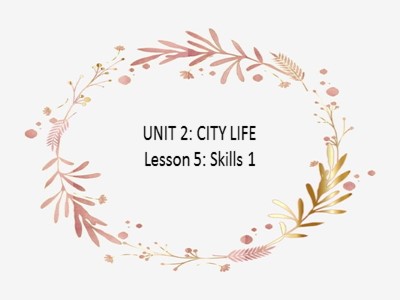Bài giảng Tiếng Anh Lớp 9 - Unit 2: City life - Lesson 5: Skills 1

2. Read the passage quickly and find the information to fill the blanks.
1. The name of the organization doing the survey:
-The organization doing the survey is The Economist Intelligence Unit (EIU)
2. The year of the survey:
-2014
3. The names of the best city and the worst cities:
- The best city: Melbourne
- The worst cities: Dhaka, Tripoli, and Douala
Bạn đang xem tài liệu "Bài giảng Tiếng Anh Lớp 9 - Unit 2: City life - Lesson 5: Skills 1", để tải tài liệu gốc về máy bạn click vào nút DOWNLOAD ở trên
UNIT 2: CITY LIFELesson 5: Skills 1I.VOCABULARY-determine (v) : quyết định-conflict (n) : sự xung đột-index (n) : chỉ số-factor (n) : yếu tố-rank (v) : phân loại, liệt vào hạng-urban sprawl (n) : sự phát triển đô thị/ sự mở rộng đô thịII,READING1. Work in pairs. What features are important to you in a city? Put the following in order 1-8 (1 is the most important).12. Read the passage quickly and find the information to fill the blanks.1. The name of the organization doing the survey:2. The year of the survey:3. The names of the best city and the worst cities: Which is the best city in the world to live in? Every year, the Economist Intelligence Unit (EIU) conducts a fascinating survey todetermine which cities around the world “provide the best or worst living conditions”. It uses factors such as climate, transport, education, safety, and recreational facilities in cities. It gives scores for each, and ranks the cities in order – from the best to the worst.For the year 2014, the top 10 cities came from Australia, Canada, Europe, and New Zealand. Melbourne in Australia had the highest score, which means it is the most ‘liveable’ city. Some famous cities came in the top 20, such as Tokyo (19th) and Paris (17th). Perhaps surprisingly, Osaka (13th) had the best score in Asia. Cities with major conflicts tended to score the lowest. In these countries, living conditions were the most diffi cult or dangerous. Among the worst cities on the list were Dhaka in Bangladesh, Tripoli in Libya, and Douala in Cameroon. However, some other organisations and individuals would like to add other factors to the index. They say that a city’s green space, urban sprawl, natural features, cultural attractions, convenience, and pollution should be added to the list.2. Read the passage quickly and find the information to fill the blanks.1. The name of the organization doing the survey:2. The year of the survey:3. The names of the best city and the worst cities: -The organization doing the survey is The Economist Intelligence Unit (EIU) -2014- The best city: Melbourne - The worst cities: Dhaka, Tripoli, and Douala3. Read the passage again and answer questions.1. What factors are used by EIU to range the world cities?2. Where were some famous cities on the list?3. Why were Dhaka, Tripoli and Douala ranked among the worst cities? 4. Which was the most “liveable” city in Asia?5. What are some factors that should be added to the index?Which is the best city in the world to live in? Every year, the Economist Intelligence Unit (EIU) conducts a fascinating survey todetermine which cities around the world “provide the best or worst living conditions”. It uses factors such as climate, transport, education, safety, and recreational facilities in cities. It gives scores for each, and ranks the cities in order – from the best to the worst.For the year 2014, the top 10 cities came from Australia, Canada, Europe, and New Zealand. Melbourne in Australia had the highest score, which means it is the most ‘liveable’ city. Some famous cities came in the top 20, such as Tokyo (19th) and Paris (17th). Perhaps surprisingly, Osaka (13th) had the best score in Asia. Cities with major conflicts tended to score the lowest. In these countries, living conditions were the most diffi cult or dangerous. Among the worst cities on the list were Dhaka in Bangladesh, Tripoli in Libya, and Douala in Cameroon. However, some other organisations and individuals would like to add other factors to the index. They say that a city’s green space, urban sprawl, natural features, cultural attractions, convenience, and pollution should be added to the list.3. Read the passage again and answer questions.1. What factors are used by EIU to range the world cities?2. Where were some famous cities on the list?3. Why were Dhaka, Tripoli and Douala ranked among the worst cities? 4. Which was the most “liveable” city in Asia?5. What are some factors that should be added to the index? -Climate, transport, education, safety, and recreational facilities in cities are used by EIU to range the world cities . - Among the top 20.-Because the living conditions there were the most difficult or dangerous.-Osaka was.-They are a city's green space, urban sprawl, natural features, cultural attractions, convenience, and pollution.III,SPEAKING4a. Work in groups of five or six. Conduct a survey to rank your own town/city or a town city you know. Give from 10 points (the best to 1 point (the worst) to each factor.Ask each student in your group the question: "How many points do you give to factor 1 - safety? "Then write the points in the table.Ask each student in your group the question: "How many points do you give to factor 1 - safety? "1. safety2. transport3. education 4. climate5. culture 6. facilities7. entertainment8. natural features9. urban sprawl10. pollution controlSt AStBSt CSt DSt EFactors Points given Total pointsSPEAKINGb, Work out the final result of your group. Then present it to the class. Is your group's result the same or different from that of other groups?HOMEWORK-Learn by heart the new words-Prepare : Skills 2
Tài liệu đính kèm:
 bai_giang_tieng_anh_lop_9_unit_2_city_life_lesson_5_skills_1.ppt
bai_giang_tieng_anh_lop_9_unit_2_city_life_lesson_5_skills_1.ppt



